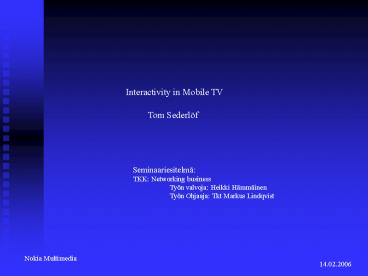Interactivity in Mobile TV - PowerPoint PPT Presentation
Title:
Interactivity in Mobile TV
Description:
Interactivity in Mobile TV Tom Sederl f Seminaariesitelm : TKK: Networking business Ty n valvoja: Heikki H mm inen Ty n Ohjaaja: Tkt Markus Lindqvist – PowerPoint PPT presentation
Number of Views:87
Avg rating:3.0/5.0
Title: Interactivity in Mobile TV
1
Interactivity in Mobile TV
Tom Sederlöf
Seminaariesitelmä TKK Networking business Työn
valvoja Heikki Hämmäinen Työn Ohjaaja Tkt
Markus Lindqvist
Nokia Multimedia
14.02.2006
2
- Introduction
- Layered Model Of Mobile Broadcasting
- Radio Layer
- System Layer
- Business Environment
- Interactivity
- Interactivity in Mobile TV
- Conclutions
3
Introduction
- Motivation
- Costs transimitting broadcast type of data is
extremely high in point-to-point/cellular
networks - Mobile broadcasting technologies enable the
broadcasting to mobile devices - TV is the most commonly spread broadcast service
- When integrating the broadcast based TV service
to mobile phones, a single device uses the
one-to many and point-to-point networks
- Scope
- Scheduled broadcast services
- Main focus on TV and interactive services
- Presened analysis applicable also to other
non-TV broadcast services
- Methodoly
- Literature survey
- Non structured open discussions with experts
4
Layered Model of Mobile Broadcasting
- Developed for the thesis
- Previous studies on mobile broadcasting base on
vertical approach - Model used as framework throughout the analysis
- Each layer studied separately
- Main focus on Client Application Layer,
especially on Mobile TV and possibilities to
integrate interactive service components to it
5
Radio Layer of Mobile Broadcasting
- Five different major mobile broadcasting
technologies
- Digital video broadcasting for Handheld (DVB-H)
- Multimedia Broadcast Multimedia Service (MBMS)
- Terrestrial Digital Multimedia Broadcasting
(T-DMB) - Integrated Services Digital Broadcast (ISDB-T)
- Forward Link Only ( FLO )
- Broadcasting technologies provide the high data
rate downlink and existing cellular networks - the uplink needed for interacting
6
System Layer
Two different system level solutions
- IP datacasting (DVB-H)
- MediaFlo (FLO)
- Service Enablers of System Layer
- Service Discovery
- Security
- Purchase Billing
- Generic Services provided by System Layer
- Streaming
- FileCasting
- Intractivity
7
Business Environment of Mobile Broadcasting
Generic business model of mobile broadcasting -
presents the functional roles needed in MB -
Companies will act in one or more roles
Division of functional roles in mobile TV pilots
Case Oxford
Case Helsinki
Case Barcelona
8
Business Environment of Mobile Broadcasting
- The mapping between functional business roles and
actors
9
Interactivity
- Interactive services in normal TV
- Pre-existing interactivity
- 24/7 services
- Enchanced TV
- Terminal Constraints in Mobile TV services
- Screen Size
- Input Device
- Native Application Set
- Interactive services in mobile TV
- Simulcasting
- Enhanced simulcast
- Mobile TV dedicated content
Mobile TV Terminals
10
Interactivity in Mobile TV
- Examples of Interactive Services
- Simulcasting
( from Nokia 7710 during Finnpilot)
- Enhanced Simulcast
( concept service)
- Mobile TV dedicated content
( from Nokia 7710 during Finnpilot)
11
Interactivity in Mobile TV
- Presentation of interactive services
- In a spesific banner area beside picture
- On top of picture
( concept service)
( concept service)
- Services should be drawn to the screen in
terminal, not burnt to the picture
12
Conclutions
- Services provided by mobile broadcast have affect
to three dimensions,
- When the broadcasted content is simulcast, a
consistensy on how the business environment is
set - up and how the functional roles are adopted by
actors involved within the busines can be seen,
but - as the broadcasted content diversifies to
include interaction and non-TV content, - so do the business models.
13
Conclutions
- The co-operation of actors already posessing
relevant competences, mostly todays broadcasting
and - telecommunication operators, is most likely seen
in vast majority of business models of mobile TV.
- It is likely that there will not be a clear
winner technology in mobile TV on global level
but the mobile - broadcasting market will remain geographically
fragmented. - Including interactivity to mobile TV has a
potential but exploiting it successfully requires
proper - implementation both from broadcast system and
terminal side, i.e. integrating the interactive
services to - the broadcast feed and ensuring the ease of use
in terminals. - Interactive services provided in set-top-boxes
are not suitable for mobile TV as such, but some
of the - interactive service types are applicable to
mobile TV. - Interaction should be introduced to mobile TV
through enhanced simulcast, in practice this
means - embedding services like voting, links, chats,
gambling and gaming to the broadcasted
programming. - Because of the lack of empirical data on
interactive services in mobile TV further study
is needed. - The upcoming mobile TV trials and commercial
solutions give the possibility to experiment with
- interactive mobile TV and will provide data that
can be used in further studies.
14
Thank You
Tom Sederlöf Nokia, Multimedia
15
Example implementation of MB system capable of
interaction































